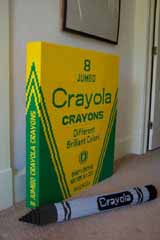
The Strong Museum in Rochester, New York asked me to build such a model for their exhibit of the National Toy Hall of Fame (of which both LEGO and Crayola are entrants).
It had been a long time since I had handled a box of Crayola Crayons, but I certainly had strong memories of the 'box of 8' and the 'box of 64' (which had the crayon sharpener built into the base).
I was a bit concerned because the Crayola Boxes of today are covered with much fancier graphics and fonts than the boxes of years past. Originally I had hoped to build a box that would tower as tall as 7 feet high, but due to budget and time constraints this was reined in down to a more managable size of about 3 feet tall. At that size I was afraid that I might not be able to incorporate all of the text that is on the outside of a box of crayons (there is much more than the familiar words 'Crayola Crayons').
After some discussion it was decided that I would build an 'old style' box of Jumbo 8 crayons. Such a box was only two colors: yellow and dark green. Plus the text on the box was much more straightforward (though at the time I was still not sure whether I could construct all of the words).
Also, the older box of 8 crayons used the following colors: black, brown, orange, violet, blue, green, red and yellow. These were all hues I could build out of LEGO bricks (to be honest, at the Crayola Website I could not even find a box of eight crayons for sale... it appears they now sell a box of 16 instead).
Of course, violet (purple) and orange are not the most common LEGO brick colors, but fortunately LEGO has recently been selling a bucket of bricks that includes those two colors (set number 7837). Using the Peeron Inventory website to get the piece quantities, I calculated that I would need 5 such buckets to build the 'heads' of the purple and orange crayons (of the 8 crayons built, all but the black crayon would been 'in the box' with only there tips showing... so I decided to only build the heads of those crayons).
The construction was very straightforward. I had pictures of each side of the original box, so I just picked an appropriate width (102 studs) and started to build upward. Mostly 2x2 yellow and green bricks were used (no glue). I would constantly refer to the pictures to see were I would need to construct lettering for the box (the wording is not identitcal on the front and back).
Fortunately I had oodles of green and yellow plates with which to work.
Construction the various texts proved to be quite challenging but fun. Some of the lettering was built sideways, some upright, and some using a combination of both. I did all of the lettering by hand, no computer programs were used. I was please to find that I was able to create all of the letter on all sides of the box. The only word I left off was 'black' on the side of the separated crayon.
I decided to leave the lid of the box unbuilt. This was for two reasons: 1) I could not think of a good way to mimic a thin lid that could be 'open' and strong enough for a good display, and 2) the display case into which this will be placed is only 42 inches tall -- the box without the lid was already 37 inches high, so there wasn't really room for the lid anyway.
Besides, the most important feature of the box is seeing the colorful crayons. I built 7 of the crayon tips into the the box proper, but the black crayon I built separately so it could be positioned out of the box on display (I chose the black crayon to be the separate one because I knew the label of the crayon is supposed to be a lighter version of the color of the crayon itself. A black crayon would thus have a gray label, and gray bricks are common enough to get -- as opposed to, say, light blue bricks for a blue crayon).
Overall the box is 101 rows tall. It weighs probably 80 pounds (the walls are two studs thick, but the box is mostly hollow). Here are some pictures (you'll note that there is a seam halfway up the box where it is not fastened together. This is because I will ship it in halves which will be then been assembled on site).